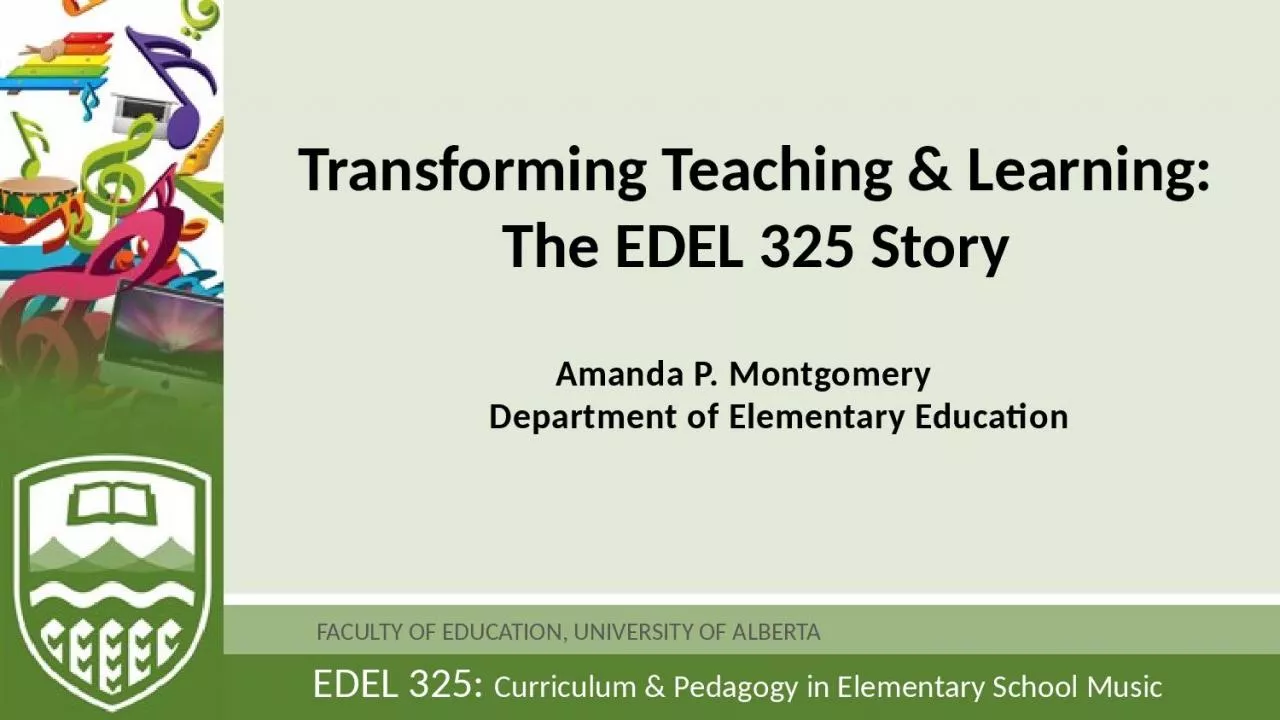

The EDEL 325 Story Amanda P Montgomery Department of Elementary Education Course Type One of 7 Curriculum amp Pedagogy courses in BEd Elementary Content Theory and research surrounding childrens musical development and learning ID: 1018110
Download Presentation The PPT/PDF document "Transforming Teaching & Learning:" is the property of its rightful owner. Permission is granted to download and print the materials on this web site for personal, non-commercial use only, and to display it on your personal computer provided you do not modify the materials and that you retain all copyright notices contained in the materials. By downloading content from our website, you accept the terms of this agreement.
1. Transforming Teaching & Learning:The EDEL 325 StoryAmanda P. Montgomery Department of Elementary Education
2. Course Type:One of 7 Curriculum & Pedagogy courses in BEd. ElementaryContent:Theory and research surrounding children’s musical development and learning Concrete application of pedagogyStructure: Inquiry & constructivist based ----------------------------------------------------------------------------------Current Format: F2F sections of 35-40 students each - taught in variable time formats (3/4/8 weeks compressed and regular 13 weeks)
3. Challenges:My experience: blended and online graduate teachingNo current undergraduate modelsEDEL 325 needs lots of hands-on application time – how to keep constructivist/inquiry based model
4. I read the literature on blended learning…Definitions:“the thoughtful integration of classroom, face-to-face learning experiences with online learning experiences”(Garrison & Kanuka, 2004, p.96)can be any % mixture of F2F and online learning depending on context (Halverson et al., 2012)is not simply taking F2F material and moving it online but rather involves a complete rethinking and redesign of instruction (Vaughn, 2007)
5. Early goals highlighted blended learning’s potential to transform higher education towards:More constructivist and inquiry based learningMore interactive and collaborative learning with less big hall lectureBuilding communities of inquiry
6. More recently as the flipped classroom has gained conversation time, goals have expanded to include:The opportunity for students to take more ownership and responsibility for their learning (i.e., online work first – application in F2F second)The opportunity for individual pacing and greater access for review of course content (e.g., screencasts, podcasts, etc.)
7. So as a result, I decided to be innovative and create a ‘flipped’ music classroom within a blended formatDeveloped a theoretical learning model for this flipped-blended classroom EARS’s of Learning: Explore-Apply-Reinforce
8. EAR’s of Learning1. Explore: Individual online exploration of course material through multiple modalities (e.g., screencasts, podcasts, videos, readings, group discussions, etc.) in conjunction with practice quizzes and/or assignments – Moodle eClass2. Apply: Collaborative, synchronous application of this course material during the F2F class – on campus3. Reinforce: Individual review of course material online as needed plus assignments – Moodle eClass
9. 10 Units20 ModulesA: Interactive Class LIVE! E: Flexlab R: AssignmentEDEL 325 Blended Learning
10. 10 Units20 ModulesA: LIVE! Online Class via Adobe ConnectE: Flexlab R: Flexlab RevisitedEDEL 325 Online Learning (ATEP)
11.
12. Things to think about…Read a bit of the literatureLook at other instructor’s courses (amanda.montgomery@ualberta.ca) Tap into the campus supportStart small - a couple of modulesBe creative with learning objectives – no one size fits all